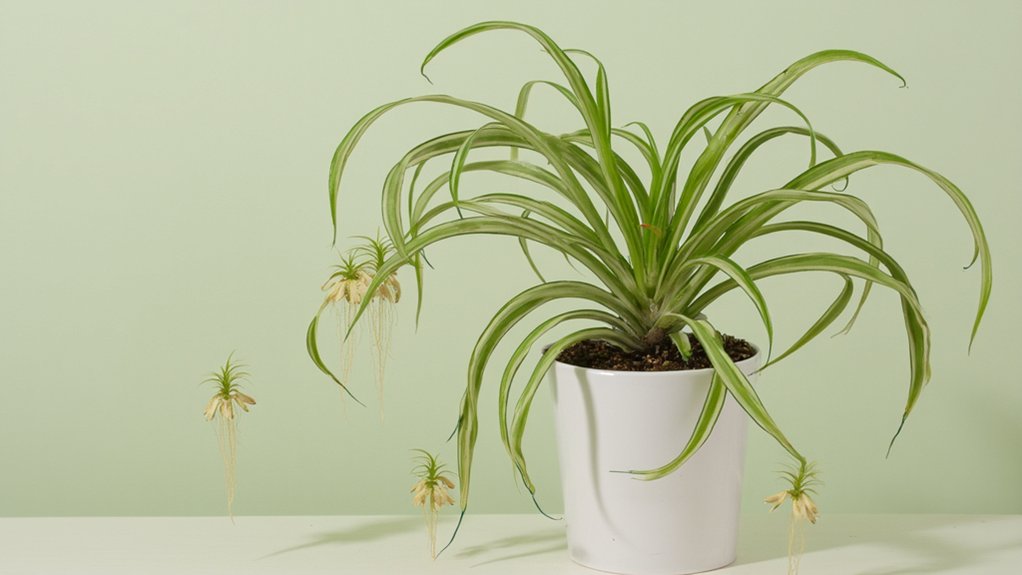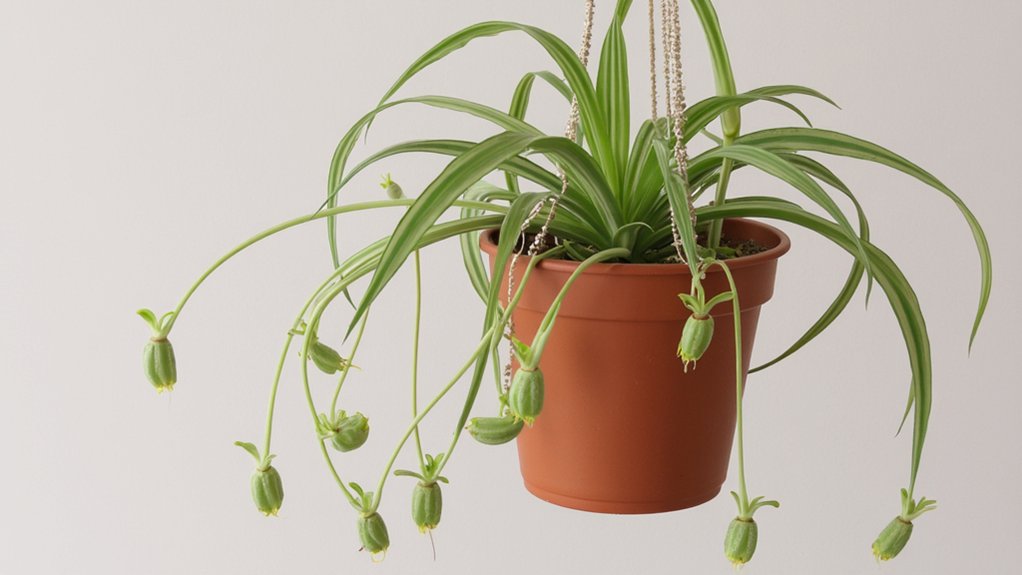Did you know that a single spider plant can produce up to 40 baby offshoots in just one growing season? These remarkable plants, scientifically known as Chlorophytum comosum, have perfected the art of reproduction through specialized stems called stolons. You’ll find these runners dangling from mature plants like nature’s puppet strings, each one ready to spawn an identical clone. The science behind this efficient propagation method reveals fascinating insights about plant survival strategies.
Contents
- 1 The Evolution of Spider Plant Reproduction
- 2 Understanding Stolons: Nature’s Growth Strategy
- 3 The Biology Behind Spider Plant Runners
- 4 Environmental Triggers for Plantlet Formation
- 5 Genetic Advantages of Vegetative Propagation
- 6 The Role of Hormones in Runner Development
- 7 Energy Distribution Between Parent and Babies
- 8 Optimal Conditions for Runner Production
- 9 Survival Benefits of Multiple Offspring
- 10 Natural vs. Cultivated Spider Plant Reproduction
The Evolution of Spider Plant Reproduction

While many houseplants spread through seeds or root division, spider plants have evolved a fascinating method of reproduction through stolons, or runners. You’ll notice these long, arching stems extending from the mother plant, reaching lengths of 12-24 inches.
At the end of each stolon, you’ll find miniature plantlets, complete with their own root systems and leaves. This evolutionary adaptation allows spider plants to colonize new territory without relying on pollination or seasonal timing.
When these baby plants touch soil, they’ll quickly establish themselves, creating independent specimens that can detach from the parent plant once they’re self-sufficient.
Understanding Stolons: Nature’s Growth Strategy

Although stolons may look like simple stems, they’re actually specialized plant structures that serve as nature’s highway system for growth and reproduction. You’ll find these runners extending horizontally from your spider plant, reaching lengths of up to 3 feet in ideal conditions.
When you examine a stolon closely, you’ll notice nodes appearing at regular intervals, typically every 4-6 inches. These nodes contain everything needed to form new plantlets, including root primordia and leaf buds. Your spider plant cleverly uses these runners to position its offspring away from itself, reducing competition for resources while expanding its territory.
The Biology Behind Spider Plant Runners

Once a spider plant reaches maturity, its biology shifts into an impressive reproductive mode that you’ll witness through runner production. The plant’s specialized stems, called stolons, emerge from the crown and extend up to 2-3 feet, carrying nodes where baby plants will form.
These runners develop when your plant’s receiving 12-14 hours of indirect light daily and temperatures stay between 65-75°F. Each stolon can produce 3-4 plantlets, known as spiderettes, which develop their own root systems while still attached to the mother plant.
You’ll notice tiny white bumps forming along the runners first, followed by miniature rosettes that eventually become fully formed baby plants.
Environmental Triggers for Plantlet Formation
When spider plants receive specific environmental cues, they’ll begin their fascinating process of plantlet production. You’ll notice this happening when days become longer than 12 hours and temperatures stay between 70-80°F.
Light intensity plays an essential role, with bright, indirect sunlight triggering the most vigorous plantlet growth. If you’re keeping your spider plant in lower light conditions, you’ll see fewer runners and babies forming.
Moderate stress factors, like slightly root-bound conditions or brief periods of drought, can actually stimulate plantlet production. Your plant’s maturity matters too – it typically won’t produce babies until it’s at least one year old.
Genetic Advantages of Vegetative Propagation
Through vegetative propagation, spider plants create genetic copies that preserve their most successful adaptations. You’ll find this process guarantees the offspring maintain vital traits like drought tolerance and specific leaf patterns that helped the parent plant thrive.
When you examine a spider plant’s runners, you’re seeing nature’s proven survival strategy at work. Each plantlet carries identical DNA to its parent, which means it’s already pre-programmed to handle local growing conditions. This genetic uniformity gives the species a competitive edge, as you won’t have to wait for beneficial mutations to develop through seed reproduction.
These clones fundamentally function as an insurance policy against environmental challenges, securing the plant’s genetic legacy.
The Role of Hormones in Runner Development
Plant hormones orchestrate the distinctive growth patterns you’ll see in spider plant runners. Auxins and gibberellins work together, triggering the elongation of specialized stems called stolons that can reach 2-3 feet in length.
You’ll notice that cytokinins concentrate at the runner’s nodes, stimulating the formation of baby plantlets. These hormones regulate cell division and shoot development, while ethylene helps determine the spacing between offshoots, typically 4-6 inches apart.
When light levels drop below 600 foot-candles, your spider plant’s hormone production shifts, producing more runners. This explains why you’ll often see increased stolon development during shorter autumn days.
Energy Distribution Between Parent and Babies
As your spider plant produces babies, it carefully balances energy distribution between itself and its offspring. The parent plant typically allocates 20-30% of its resources to developing plantlets, while maintaining 70-80% for its own growth and survival.
You’ll notice the parent plant’s growth may slow during heavy runner production, as each baby requires nutrients, water, and photosynthetic energy. The parent diverts sugars and minerals through the stolon, or runner stem, supporting 3-5 plantlets at once.
Once babies develop their own roots, they’ll gradually become self-sufficient, allowing the parent plant to redirect energy back to its growth.
Optimal Conditions for Runner Production
When spider plants receive 12-14 hours of bright, indirect sunlight daily, they’ll begin producing runners in earnest. You’ll want to maintain temperatures between 65-75°F (18-24°C) and moderate humidity levels around 50-60%.
For maximum runner production, keep your soil’s pH between 6.0-6.5, and allow the top inch to dry between waterings. During the growing season (spring through fall), fertilize every 2-3 weeks with a balanced, water-soluble fertilizer at half strength.
Don’t be surprised if your plant stops producing runners in winter—it’s normal. Once days lengthen and temperatures warm up, your spider plant will resume creating babies.
Survival Benefits of Multiple Offspring
The remarkable production of runners by spider plants serves a critical evolutionary purpose. When you’re growing spider plants, you’ll notice they create multiple plantlets, which increases their chances of survival through genetic diversity and spatial distribution.
If one location becomes unsuitable, the offspring on different runners can root elsewhere, ensuring the species continues. You’ll find that each baby plant is a clone of the parent, yet it might develop slight variations that help it adapt to new conditions.
These numerous offspring also provide backup if the mother plant faces disease, pests, or environmental stress, making spider plants incredibly resilient in both natural and indoor settings.
Natural vs. Cultivated Spider Plant Reproduction
Indoor spider plants follow distinctly different reproductive patterns compared to their wild counterparts in southern Africa. In nature, they’ll primarily spread through seeds after flowering, while also producing runners with plantlets that root directly into soil. Your houseplant, however, rarely flowers or sets viable seeds indoors.
When you’re growing spider plants at home, they’ll mainly reproduce through those characteristic runners, or stolons, that dangle downward. You can encourage this process by maintaining temperatures between 65-75°F and providing bright, indirect light. The plantlets will develop roots while still attached, making propagation easier than seed-starting would be.
